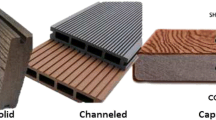Conclusions
-
1.
Use of a ballast ensures a substantial increase of the energy capacity per volume of a flywheel only when the hoop of the flywheel is made of organoplastic, the maximum increase then reaching about 50%, while for glass-, carbon-, and boron-plastic this maximum increase is an insignificant 7–14%.
-
2.
In the case of a ballast in the form of a ring fastened only to the hoop, with the ballast dimensions optimally selected, the maximum energy capacity of the flywheel depends only slightly on the ballast density.
-
3.
In the case of a ballast in the form of a solid disk between hoop and shaft the maximum energy capacity per volume is attained when the hoop material and the ballast material have approximately equal densities, while the maximum energy capacity per mass will be attained by means of a ballast with minimum density.
-
4.
The proposed method of analysis narrows down the range of search for the optimum relation between hoop and ballast dimensions.
Similar content being viewed by others
Literature cited
N. V. Gulia, Flywheel Engines [in Russian], Moscow (1976).
G. G. Portnov and V. L. Kulakov, “Energy capacity of flywheels made of composite materials and produced by winding,” Mekh. Polim., No. 1, 73–81 (1978).
R. F. Post and S. F. Post, “Flywheels,” Scientific American,17, 19–23 (1973).
E. D. Reedy and G. P. Gerstle, “Design of spoke-rim composite flywheels,” in: Symposium Proceedings on Flywheel Technology, San Francisco (1977), pp. 99–110.
L. N. Seleznev and G. G. Portnov, “Chord winding of disks with tapes of composite materials,” Mekh. Polim., No. 6, 998–1001 (1977).
C. E. Knight, I. I. Kelly Jr., R. L. Huddleston, and R. E. Pollard, “Development of the ‘bandwrap’ flywheel,” Symposium Proceedings on Flywheel Technology, San Francisco (1977), pp. 137–154.
C. C. Chamis and L. I. Kiraly, “Rim-spoke composite flywheels: detailed stress and vibration analysis,” Symposium Proceedings on Flywheel Technology, Lawrence Livermore Lab. (1975), pp. 110–116.
S. G. Lekhnitskii, Anisotropic Plates [in Russian], Moscow (1957).
Author information
Authors and Affiliations
Additional information
Translated from Mekhanika Kompozitnykh Materialov, No. 2, pp. 291–299, March–April, 1980.
Rights and permissions
About this article
Cite this article
Kulakov, V.L., Portnov, G.G. Effectiveness of a ballast in flywheels made of composite materials. Mech Compos Mater 16, 218–225 (1980). https://doi.org/10.1007/BF00603936
Received:
Issue Date:
DOI: https://doi.org/10.1007/BF00603936




